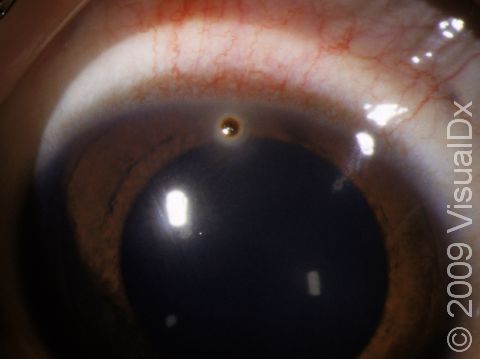Corneal Foreign Body
A corneal foreign body occurs when the cornea has a piece of foreign matter lodged in it. The most common types of foreign bodies include particles of dust, debris (eg, metal, wood), paint chips, and plant materials.
Who's At Risk?
A person with a corneal foreign body is usually one who failed to use proper eyewear protection while working under risky conditions. Using a grinding or drilling device with metal, cutting or scraping wood, working in the garden, high wind conditions, and being in dusty or debris-laden areas are all considered risk areas, and the wearing of protective eyewear is mandatory. A corneal foreign body can also result simply from walking down the street or riding in a car with the top or window down.
Signs & Symptoms
Sometimes, one can look directly at the eye and see the foreign object embedded in the cornea. However, it is the feeling of something in your eye that will not wash out that typically suggests you may have a corneal foreign body, plus any or all of the following:
- Sharp pain
- Burning
- Scratchy feeling
- Excessive tearing
- Blurred vision or vision loss
- Redness of the eye
- Blood on the white of the eye
- Sensitivity to light
- Difficulty opening the eye
Self-Care Guidelines
As with corneal abrasions and recurrent erosion of the cornea, self-care includes:
- Never rubbing the involved eye at any time.
- Using artificial tears to bathe the eye.
- Using clean water to gently rinse the eye.
- Using sunglasses to reduce light sensitivity.
- Trying to keep the eye shut after gentle rinsing.
- Gently removing a contact lens, if present, and leaving it out until the eye is healed.
Remember that taking precautions like wearing protective eyewear will significantly reduce your risk of corneal foreign body.
Note:
Often, simply rinsing the eye will eliminate the corneal foreign body. Another measure to try is to gently pull the upper eyelid over the lower eyelid and release gently. This maneuver will often dislodge the foreign body so that it will wash out. Contact lens wearers should always have a back-up pair of glasses for when contact lenses shouldn’t be worn.
More information can be found about corneal abrasions and recurrent erosion of the cornea in their respective diagnoses.
Treatments
Most often, the physician will be able to remove the corneal foreign body with very simple instruments. And, following that removal, you will probably be treated with antibiotic drops during the day and antibiotic ointment at night for a few days to prevent infection. However, if the foreign body is too deeply embedded in the cornea or there is evidence of a far more serious injury (such as penetration or perforation of the eye), an eye care professional will be called to care for you. High-velocity foreign bodies can cause very serious damage to the eye, including the possibility of permanent blindness. Be sure to wear the proper protective eyewear when you might be at risk. Lastly, even though you may feel fine, never miss follow-up appointments in case something has gone wrong that you’re not aware of.
Visit Urgency
All children with a suspected corneal foreign body need medical evaluation. Adults should seek medical attention if self-care measures have not helped or if:
- The suspected foreign body is metal, plant, or wood, especially if it came in contact with the eye with significant velocity.
- You or an observer can see the object still embedded in the cornea.
- There is persistent pain that is increasing.
- There is progressive worsening of vision or initial significant loss of vision.
- There is any bleeding, either on the surface of the eye or around the eye.
- There is mucoid, pus, or bloody discharge.
- Symptoms persist beyond 24 hours despite having already removed the foreign body.
Trusted Links
References
Yanoff M, Duker JS, eds. Ophthalmology. 2nd ed, p. 1010. St. Louis, MO: Mosby, 2004.
Last modified on October 10th, 2022 at 3:39 pm

Not sure what to look for?
Try our new Rash and Skin Condition Finder
